A disputed insurance claim heading for trial next year over construction of Washington, D.C.'s two-year-old Frederick Douglass Memorial Bridge revolves around the design-build joint venture's problems in 2019 with concrete voids and honeycombing. The flaws required demolition and rebuilding costing millions of dollars.
The disputed insurance payout is considered a potentially important test of insurance policy language, especially the London Engineering Group 3 builders' risk policy exclusion. "There have been no published court cases in the United States that interpret the meaning" of the comparatively new exclusion meant to define and limit the insurers' obligation to pay, according to Steven Coombs, president of consultant Risk Resources.
When a federal judge on Sept. 29 granted the design-build joint venture's motion for summary judgment in its favor on the breach-of-contract claim in the lawsuit against the insurer, the decision brought fresh attention to the case.
Opened in 2021, the bridge was built near a 73-year-old structure of the same name spanning the Anacostia River that was demolished as part of the project.
The 1,600-ft-long bridge is supported by three sets of parallel above-deck steel arches with no external bolted connections. The arches bear at water level on V-piers, which are constructed of cast-in-place, high-strength concrete. Earlier this year, a panel of industry experts named the bridge project as an award of merit winner in the ENR MidAtlantic Best Projects competition for 2023.
Though the concrete was post-tensioned to inhibit cracking, numerous microcracks—which were featured in a report by a District of Columbia television station in February—did appear on the structure. A statement from the district Dept. of Transportation said the cracks were normal in this type of concrete construction.
The design-build joint venture, Watsonville, Calif.-based Granite Construction Inc. and Atlanta-based Archer Western, had obtained a builder's risk policy from Lexington Insurance Co. AECOM was the main design engineer on the project and is not part of the litigation.
Work on the bridge began in 2017 but the key events in the claim came in summer of 2019, when the concrete for the V-piers was placed. According to the joint venture's court complaint filed that year, workers were able to vibrate the concrete in most of the forms. But the tips of the abutments and V-Piers were too congested with rebar and connecting hardware, so access holes were created in the sides of the formwork to allow vibration equipment inside.
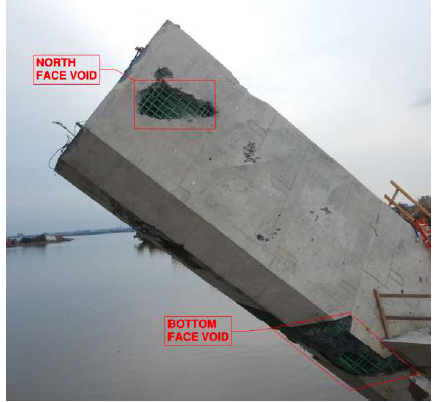
Void locations described in an engineering report about the concrete problems.
Image: Federal court filing
When the joint venture's crews removed the formwork, they discovered porosity and honeycombing in two piers and in both legs of one abutment. Honeycombing, when mortar fails to effectively fill the spaces between course aggregate particles, had weakened the concrete so that it could not support the loads involved, according to the original court complaint.
By the fall of 2019, AIG, Lexington's parent company, had retained DeSimone Consulting Engineers to determine the cause of the damage. The engineer's report blames the honeycombing on inadequate vibration and described voids in different locations. One was a 6-ft-square up to 30 in. deep. Another measured 3 ft x 6 ft by 8 in. deep. Rebar was visible inside the voids.
DeSimone's report also describes the demolition and repair efforts of October and November 2019. They included construction of falsework ramps to access the trouble spots and the use of a saw equipped with a diamond-infused wire. The wire was placed around the tip of the abutment leg.
Once the cut was made, DeSimone's report states, the crews facilitated hooking and lifting by coring a pick-point through the width of the abutment tip.
Neither the contracting joint venture, the insurer nor district officials returned calls and emails seeking comment.
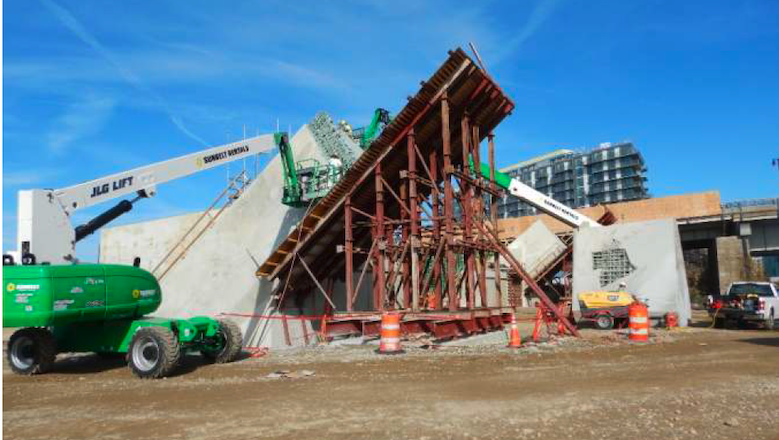
Repair work being performed on a bridge section in 2019.
Image: Federal court filing
In a letter by John A. Catania, AIG's senior major loss director, to Jack Slattery of Archer Western Constructors, Catania noted that the DeSimone report indicates the presence of several large areas where the concrete was soft and easily removed. Catania also wrote that the "surface distress" on the west abutment and V-piers "is consistent with honeycombing."
"Lexington has determined that the costs that [the joint venture] will incur with respect to the defectively constructed abutments and piers are not covered by the policy," Catania wrote. "Accordingly, Lexington disclaims coverage for this claim."
But Judge Royce Lamberth, in his Sept. 30th ruling, delivered a blow to Lexington.
He sided with the joint venture on its motion for summary judgment, writing that the damage alleged by the joint venture "falls unambiguously within the scope of coverage." It is possible that Lexington and AIG will appeal.
What's left to be decided in the current court is whether Lexington acted in bad faith in denying the payout. Lexington, according to Lamberth's trial schedule, must designate its expert witness and produce its report on Dec. 15.



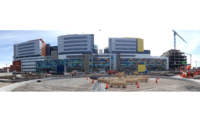
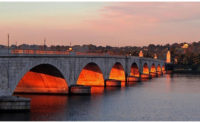
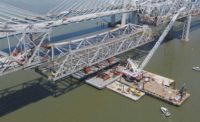
Post a comment to this article
Report Abusive Comment